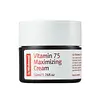What's inside
What's inside
 Key Ingredients
Key Ingredients

No key ingredients
 Benefits
Benefits

 Concerns
Concerns

 Ingredients Side-by-side
Ingredients Side-by-side

Centella Asiatica Extract
CleansingGlycerin
HumectantIsononyl Isononanoate
EmollientPropanediol
SolventNiacinamide
Smoothing1,2-Hexanediol
Skin ConditioningPolyglyceryl-3 Methylglucose Distearate
EmulsifyingAloe Barbadensis Leaf Extract
EmollientCaffeine
Skin ConditioningPanthenol
Skin ConditioningSodium Hyaluronate
HumectantCamellia Sinensis Leaf Extract
AntimicrobialMomordica Charantia Fruit Extract
Skin ConditioningSambucus Nigra Flower Extract
RefreshingLeontopodium Alpinum Extract
Skin ConditioningAllantoin
Skin ConditioningTocopheryl Acetate
AntioxidantAcrylates/C10-30 Alkyl Acrylate Crosspolymer
Emulsion StabilisingAmmonium Acryloyldimethyltaurate/Vp Copolymer
Cetearyl Alcohol
EmollientTromethamine
BufferingCentella Asiatica Extract, Glycerin, Isononyl Isononanoate, Propanediol, Niacinamide, 1,2-Hexanediol, Polyglyceryl-3 Methylglucose Distearate, Aloe Barbadensis Leaf Extract, Caffeine, Panthenol, Sodium Hyaluronate, Camellia Sinensis Leaf Extract, Momordica Charantia Fruit Extract, Sambucus Nigra Flower Extract, Leontopodium Alpinum Extract, Allantoin, Tocopheryl Acetate, Acrylates/C10-30 Alkyl Acrylate Crosspolymer, Ammonium Acryloyldimethyltaurate/Vp Copolymer, Cetearyl Alcohol, Tromethamine
Hippophae Rhamnoides Water
MaskingButylene Glycol
HumectantHelianthus Annuus Seed Oil
EmollientGlycerin
HumectantCetearyl Alcohol
Emollient1,2-Hexanediol
Skin ConditioningCetearyl Olivate
Sorbitan Olivate
EmulsifyingHydroxyethyl Acrylate/Sodium Acryloyldimethyl Taurate Copolymer
Emulsion StabilisingBetaine
HumectantCaprylic/Capric Triglyceride
MaskingElaeis Guineensis Kernel Oil
EmollientPanthenol
Skin ConditioningMacadamia Ternifolia Seed Oil
EmollientDimethicone
EmollientBeeswax
Emulsion StabilisingElaeis Guineensis Oil
EmollientEthyl Hexanediol
SolventAllantoin
Skin ConditioningArginine
MaskingXanthan Gum
EmulsifyingCarbomer
Emulsion StabilisingEthylhexylglycerin
Skin ConditioningCitrus Limon Peel Oil
MaskingLimonene
PerfumingCitral
PerfumingHippophae Rhamnoides Water, Butylene Glycol, Helianthus Annuus Seed Oil, Glycerin, Cetearyl Alcohol, 1,2-Hexanediol, Cetearyl Olivate, Sorbitan Olivate, Hydroxyethyl Acrylate/Sodium Acryloyldimethyl Taurate Copolymer, Betaine, Caprylic/Capric Triglyceride, Elaeis Guineensis Kernel Oil, Panthenol, Macadamia Ternifolia Seed Oil, Dimethicone, Beeswax, Elaeis Guineensis Oil, Ethyl Hexanediol, Allantoin, Arginine, Xanthan Gum, Carbomer, Ethylhexylglycerin, Citrus Limon Peel Oil, Limonene, Citral
 Reviews
Reviews

Ingredients Explained
These ingredients are found in both products.
Ingredients higher up in an ingredient list are typically present in a larger amount.
1,2-Hexanediol is a synthetic liquid and another multi-functional powerhouse.
It is a:
- Humectant, drawing moisture into the skin
- Emollient, helping to soften skin
- Solvent, dispersing and stabilizing formulas
- Preservative booster, enhancing the antimicrobial activity of other preservatives
Allantoin is a soothing ingredient known for its protective and moisturizingg properties. Because of this, it is often added to products with strong active ingredients.
Studies show higher concentrations of this ingredient can promote wound healing.
Though it can be derived from the comfrey plant, allantoin is produced synthetically for cosmetic products to ensure purity.
Learn more about AllantoinCetearyl alcohol is a mixture of two fatty alcohols: cetyl alcohol and stearyl alcohol. It is mainly used as an emulsifier. Emulsifiers help prevent the separation of oils and products. Due to its composition, it can also be used to thicken a product or help create foam.
Cetearyl alcohol is an emollient. Emollients help soothe and hydrate the skin by trapping moisture.
Studies show Cetearyl alcohol is non-toxic and non-irritating. The FDA allows products labeled "alcohol-free" to have fatty alcohols.
This ingredient is usually derived from plant oils such as palm, vegetable, or coconut oils. There is debate on whether this ingredient will cause acne.
Due to the fatty acid base, this ingredient may not be Malassezia folliculitis safe.
Learn more about Cetearyl AlcoholGlycerin is already naturally found in your skin. It helps moisturize and protect your skin.
A study from 2016 found glycerin to be more effective as a humectant than AHAs and hyaluronic acid.
As a humectant, it helps the skin stay hydrated by pulling moisture to your skin. The low molecular weight of glycerin allows it to pull moisture into the deeper layers of your skin.
Hydrated skin improves your skin barrier; Your skin barrier helps protect against irritants and bacteria.
Glycerin has also been found to have antimicrobial and antiviral properties. Due to these properties, glycerin is often used in wound and burn treatments.
In cosmetics, glycerin is usually derived from plants such as soybean or palm. However, it can also be sourced from animals, such as tallow or animal fat.
This ingredient is organic, colorless, odorless, and non-toxic.
Glycerin is the name for this ingredient in American English. British English uses Glycerol/Glycerine.
Learn more about GlycerinPanthenol is a common ingredient that helps hydrate and soothe the skin. It is found naturally in our skin and hair.
There are two forms of panthenol: D and L.
D-panthenol is also known as dexpanthenol. Most cosmetics use dexpanthenol or a mixture of D and L-panthenol.
Panthenol is famous due to its ability to go deeper into the skin's layers. Using this ingredient has numerous pros (and no cons):
Like hyaluronic acid, panthenol is a humectant. Humectants are able to bind and hold large amounts of water to keep skin hydrated.
This ingredient works well for wound healing. It works by increasing tissue in the wound and helps close open wounds.
Once oxidized, panthenol converts to pantothenic acid. Panthothenic acid is found in all living cells.
This ingredient is also referred to as pro-vitamin B5.
Learn more about Panthenol